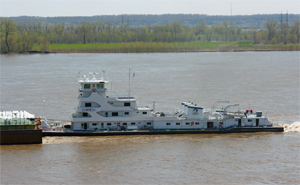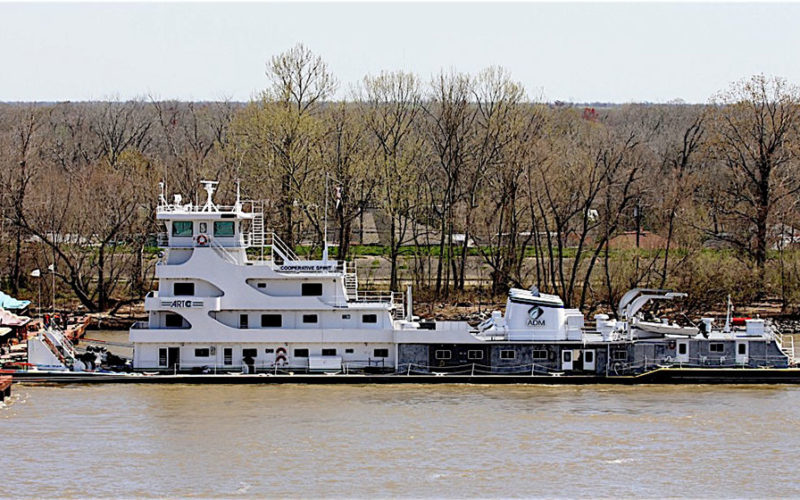The pilot of a towboat pushing 29 barges down the Mississippi River failed to compensate for the fast-moving current before hitting a bridge pier near Luling, La., federal investigators said.

Cooperative Spirit’s tow broke apart after striking the Hale Boggs Memorial Bridge at 0113 on March 15, 2020. One barge sank and another was destroyed. Total damage and lost cargo from the incident at mile 121.6 reached $1.65 million.
The pilot helming the 185-foot Cooperative Spirit acknowledged to National Transportation Safety Board (NTSB) investigators that the tow rounded 26 Mile Point out of shape for the bridge transit. He also said current pushed the tow to the left bank as it approached the span.
“The pilot chose to primarily use increased engine speed in an effort to move the tow to starboard away from the bridge pier, stating that he ‘tried to outrun (the current),’” the NTSB said in its report. “However, the tow’s course over ground did not appreciably change as engine speed increased, while the increasing speed over ground reduced the time the pilot had to maneuver.”
Authorities did not identify the pilot, who had 29 years of towing industry experience. The same mariner was at the helm of the upbound Cooperative Spirit on Jan. 26, 2020 when it collided with a downbound tow pushed by R.C. Creppel, the NTSB said. R.C. Creppel sank after the collision at 26 Mile Point and three of its four crewmembers died.
American River Transportation Co. (ARTCO) of St. Louis operated the 10,500-hp triple-screw towboat. The company removed the pilot from Cooperative Spirit for “a short period” after the fatal collision to allow him to “reset,” the report said. The length of that reset was not available.
ARTCO considered the pilot experienced and “very safety conscious” — traits that reportedly did not change after he returned to work, the NTSB said. The company did not respond to inquiries about the Hale Boggs bridge incident, or its decision to allow the pilot to return to work after the R.C. Creppel incident.
Cooperative Spirit got underway from St. Louis on March 6, 2020 with 30 barges in a six-wide, five-deep arrangement. Twenty-nine of the barges carried grain, while the 30th was empty. The tow changed crew near Baton Rouge, La., on March 10. The pilot was among the crew who came on board.
The tow made slow progress over the next several days due to stops along the way, including one in Plaquemine, La., to drop off the empty barge. Later, the tow held up awaiting space in the fleeting area at its final destination of Kenner Bend (mile 115.8). Sufficient space came available late on March 14, and Cooperative Spirit got underway at 2317. The pilot relieved the captain at midnight for a six-hour watch.
The first hour was uneventful. The tow passed the upbound bulk carrier Ikan Parang 2.5 miles upriver from the Hale Boggs bridge. The pilot initiated a flanking maneuver to bring the tow around the left-hand bend at 26 Mile Point. He completed the maneuver eight-tenths of a mile upriver from the bridge.
The Lower Mississippi River was running fast and high on the morning of the bridge strike. The Carrollton Gauge located 15 miles downriver recorded 15.3 feet — a level considered high but below flood stage. The current was running about 6 mph near the Hale Boggs bridge. An eddy also might have formed upriver from the bridge, the NTSB said, which would have made maneuvering more difficult.
The 1,195-foot tow was too close to the left descending bank rounding the bend, the report said. The pilot responded by working the throttles individually, occasionally moving the rudders to starboard. He progressively increased power to the engines until all three were at a maximum 212 shaft rpm. The pilot told investigators he tried to “outrun” the current.
“Although the pilot stated that he used starboard rudder and increased engine speed in an attempt to counteract the current, the video evidence showed he used limited rudder as the tow approached the bridge,” the report said. “Ultimately, the pilot’s actions in compensating for the strong current were ineffective, resulting in the tow hitting the bridge’s eastern tower pier.”
The tow hit the bridge at almost 12 mph. Barges ART1008 and ART44080B, on the forward section of the port string, struck the eastern pier. ART1008 sank stern first about a mile downriver, the NTSB said, while ART44080B was damaged beyond repair.

